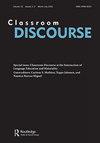Mediated learning materials: visibility checks in telepresence robot mediated classroom interaction
IF 1.6
Q2 EDUCATION & EDUCATIONAL RESEARCH
引用次数: 16
Abstract
ABSTRACT Videoconferencing is increasingly used in education as a way to support distance learning. This article contributes to the emerging interactional literature on video-mediated educational interaction by exploring how a telepresence robot is used to facilitate remote participation in university-level foreign language teaching. A telepresence robot differs from commonly used videoconferencing set-ups in that it allows mobility and remote camera control. A remote student can thus move a classroom-based robot from a distance in order to shift attention between people, objects and environmental structures during classroom activities. Using multimodal conversation analysis, we focus on how participants manage telepresent remote students’ visual access to classroom learning materials. In particular, we show how visibility checks are accomplished as a sequential and embodied practice in interaction between physically dispersed participants. Moreover, we demonstrate how participants conduct interactional work to make learning materials visible to the remote student by showing them and guiding the ‘seeing’ of materials. The findings portray some ways in which participants in video-mediated interaction display sensitivity to the possibility of intersubjective trouble and the recipient’s visual perspective. Besides increasing understanding of visual and interactional practices in technology-rich learning environments, the findings can be applied in the pedagogical design of such environments.中介学习材料:远程呈现机器人中介课堂互动的可视性检查
视频会议作为一种支持远程学习的方式越来越多地应用于教育领域。本文通过探索如何使用远程呈现机器人促进大学水平外语教学的远程参与,为视频媒介教育互动的新兴互动文献做出了贡献。远程呈现机器人不同于常用的视频会议设置,因为它允许移动和远程摄像机控制。因此,远程学生可以从远处移动基于教室的机器人,以便在课堂活动中将注意力转移到人、物体和环境结构之间。使用多模态会话分析,我们关注参与者如何管理远程呈现的远程学生对课堂学习材料的视觉访问。特别是,我们展示了可见性检查是如何在物理上分散的参与者之间的交互中作为一个顺序的和具体化的实践来完成的。此外,我们演示了参与者如何进行互动工作,通过向远程学生展示和指导他们“看到”材料,使学习材料对他们可见。这些发现描绘了视频媒介互动的参与者对主体间问题的可能性和接受者的视觉视角的敏感性的一些方式。除了增加对技术丰富的学习环境中视觉和互动实践的理解外,研究结果还可以应用于此类环境的教学设计。
本文章由计算机程序翻译,如有差异,请以英文原文为准。
求助全文
约1分钟内获得全文
求助全文

 求助内容:
求助内容: 应助结果提醒方式:
应助结果提醒方式:


